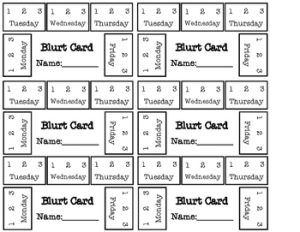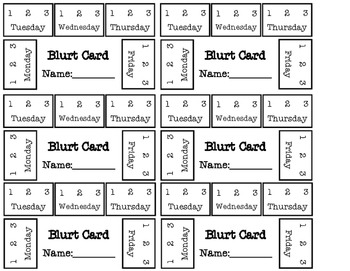Student Contributor: R. Veening
 Blurt Cards are a physical tool you can give to your students, the entire class or just a select few students, who need help with waiting their turn to talk and have trouble with raising their hand in order to speak. This tool is helpful because not only is it a physical item, but if used correctly students can receive rewards for not blurting as well as can be held accountable if they continue to speak out of turn.
Blurt Cards are a physical tool you can give to your students, the entire class or just a select few students, who need help with waiting their turn to talk and have trouble with raising their hand in order to speak. This tool is helpful because not only is it a physical item, but if used correctly students can receive rewards for not blurting as well as can be held accountable if they continue to speak out of turn.
Blurt cards can be used in a variety of ways. The simplest way I have used is first having a conversation with the students you are going to be implementing the blurt cards management tool with. This can be a positive conversation; ask your students how many blurt cards they think they should have. 3? 5? This gives students accountability in addition to a part decision in the management tool. Once there has been a discussion at the beginning of every day give those students their 3 or 5 blurt cards and reinforce that if they talk out of turn then one will be taken. Moving forward, this is where the growth takes place. If a student goes the whole week without having to have a blurt card taken then the next week, they will be given one less blurt card until they do not need them anymore. For the students who continue to lose their blurting cards there will be some form of action taken by the teacher as discipline, this can be whatever you feel is deserving. It is important that when your students go a whole week without losing a blurt card that you reward them so they see the purpose in the management tool, and they will not give up.
Personally, when I was in third grade my teacher implemented the management tool of blurt cards with me and three of my close friends who could never seem to stop talking out of term. I found this tool to be successful in my educational journey, mainly because if it was not then I would not remember it being implemented with myself twelve years later. My teacher was always upfront and honest with me even being eight years old, which is what I felt contributed to the success because I saw the purpose for what their blurt cards represented and took pride in having less and less with every week.
 The reason this management tool is connected to the supportive phase is because it gives the students the opportunity to correct their own behavior. Yes, there are steps by the teacher to put this tool into place, but the correction of the behavior relies on the student's ability to recognize they need to make a change for the better of their own and their classmates learning. I do not believe this tool relates to the preventative phase because I would never give a student who has not had an issue speaking out of turn blurt cards. Although, this can also fall under the corrective phase depending on if you use this tool in a more teacher directed way than I normally do.
The reason this management tool is connected to the supportive phase is because it gives the students the opportunity to correct their own behavior. Yes, there are steps by the teacher to put this tool into place, but the correction of the behavior relies on the student's ability to recognize they need to make a change for the better of their own and their classmates learning. I do not believe this tool relates to the preventative phase because I would never give a student who has not had an issue speaking out of turn blurt cards. Although, this can also fall under the corrective phase depending on if you use this tool in a more teacher directed way than I normally do.
The theory of influence this management tool relates to I placed as collaborative. This is because of the way I use the tool. First having a conversation allows for both the opinions of the students and teacher to influence where we need to start and where we want to set our goals at. Also, it is the student's job to hold themselves accountable but if the issue is not resolved then the teacher must step in as authority allowing for more collaboration from both parties in the classroom.
More Information –
Tool Source: Barbi Som
https://www.teacherspayteachers.com/Browse/Search:blurt%20cards


